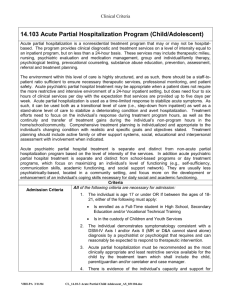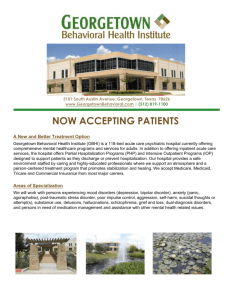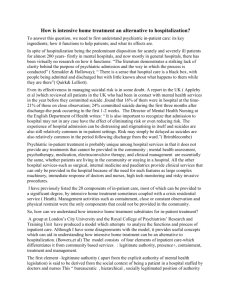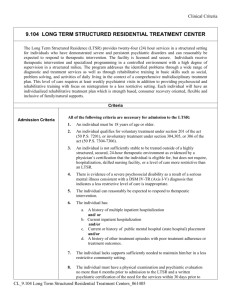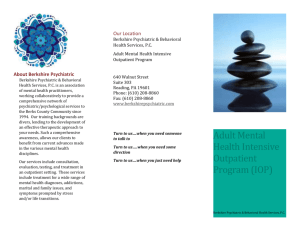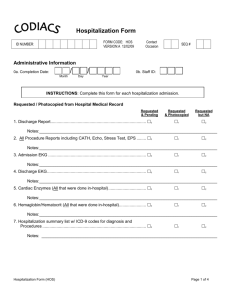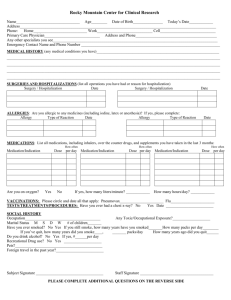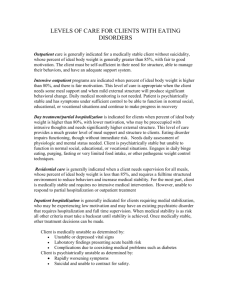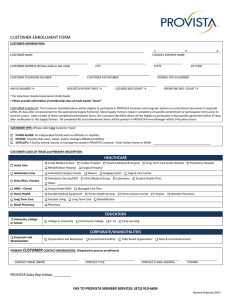Partial Hospitalization
advertisement
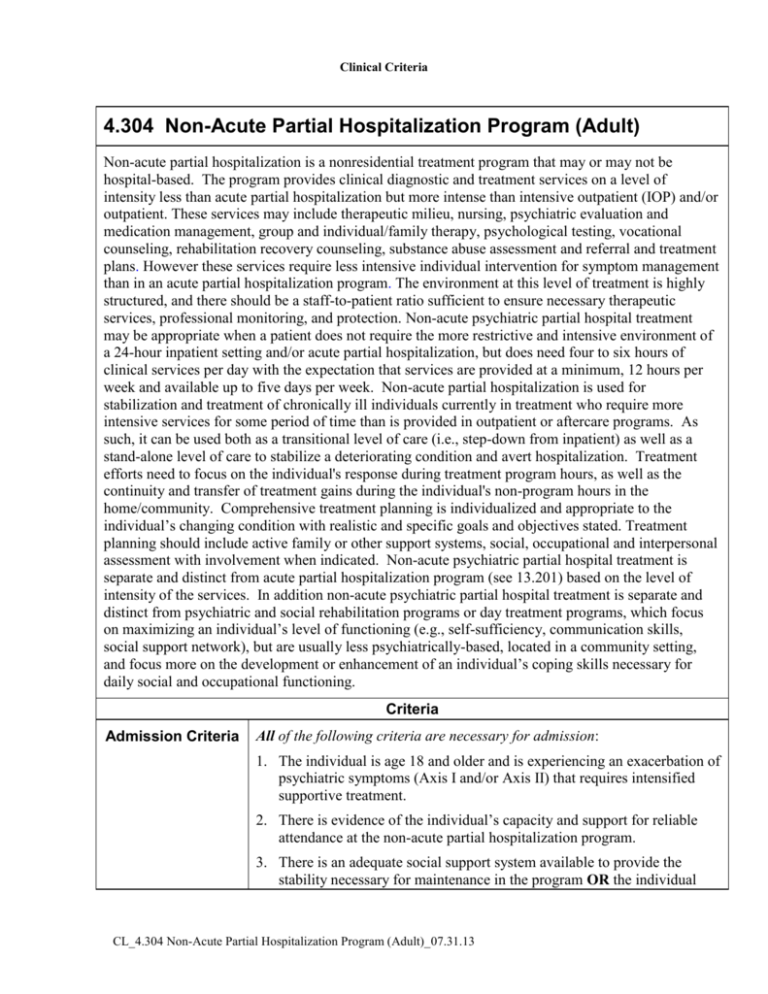
Clinical Criteria 4.304 Non-Acute Partial Hospitalization Program (Adult) Non-acute partial hospitalization is a nonresidential treatment program that may or may not be hospital-based. The program provides clinical diagnostic and treatment services on a level of intensity less than acute partial hospitalization but more intense than intensive outpatient (IOP) and/or outpatient. These services may include therapeutic milieu, nursing, psychiatric evaluation and medication management, group and individual/family therapy, psychological testing, vocational counseling, rehabilitation recovery counseling, substance abuse assessment and referral and treatment plans. However these services require less intensive individual intervention for symptom management than in an acute partial hospitalization program. The environment at this level of treatment is highly structured, and there should be a staff-to-patient ratio sufficient to ensure necessary therapeutic services, professional monitoring, and protection. Non-acute psychiatric partial hospital treatment may be appropriate when a patient does not require the more restrictive and intensive environment of a 24-hour inpatient setting and/or acute partial hospitalization, but does need four to six hours of clinical services per day with the expectation that services are provided at a minimum, 12 hours per week and available up to five days per week. Non-acute partial hospitalization is used for stabilization and treatment of chronically ill individuals currently in treatment who require more intensive services for some period of time than is provided in outpatient or aftercare programs. As such, it can be used both as a transitional level of care (i.e., step-down from inpatient) as well as a stand-alone level of care to stabilize a deteriorating condition and avert hospitalization. Treatment efforts need to focus on the individual's response during treatment program hours, as well as the continuity and transfer of treatment gains during the individual's non-program hours in the home/community. Comprehensive treatment planning is individualized and appropriate to the individual’s changing condition with realistic and specific goals and objectives stated. Treatment planning should include active family or other support systems, social, occupational and interpersonal assessment with involvement when indicated. Non-acute psychiatric partial hospital treatment is separate and distinct from acute partial hospitalization program (see 13.201) based on the level of intensity of the services. In addition non-acute psychiatric partial hospital treatment is separate and distinct from psychiatric and social rehabilitation programs or day treatment programs, which focus on maximizing an individual’s level of functioning (e.g., self-sufficiency, communication skills, social support network), but are usually less psychiatrically-based, located in a community setting, and focus more on the development or enhancement of an individual’s coping skills necessary for daily social and occupational functioning. Criteria Admission Criteria All of the following criteria are necessary for admission: 1. The individual is age 18 and older and is experiencing an exacerbation of psychiatric symptoms (Axis I and/or Axis II) that requires intensified supportive treatment. 2. There is evidence of the individual’s capacity and support for reliable attendance at the non-acute partial hospitalization program. 3. There is an adequate social support system available to provide the stability necessary for maintenance in the program OR the individual CL_4.304 Non-Acute Partial Hospitalization Program (Adult)_07.31.13 Clinical Criteria demonstrates the capacity to assume responsibility for his/her own safety outside program hours. 4. The individual’s risk to self, others, or property is not so serious as to require 24-hour medical/nursing supervision or the intensity of an acute partial hospitalization program, but does require structure and supervision for a significant portion of the day and family/community support when away from the non-acute partial hospitalization program. 5. The individual’s condition requires a comprehensive, multi-disciplinary, multi-modal course of treatment, including routine medical observation/supervision to effect significant regulation of medication and/or routine nursing observation and behavioral intervention to maximize functioning and minimize risks to self, others and property. Psychosocial, Occupational, and Cultural and Language Factors These factors may change the risk assessment and should be considered when making level of care decisions and reflected in the treatment planning process. Exclusion Criteria Any of the following criteria are sufficient for exclusion from this level of care: 1. The individual is an active or potential danger to self or others or sufficient impairment exists that a more intense level of service is required. 2. The individual does not voluntarily consent to admission or treatment and is not involuntarily committed to this level of care. 3. The individual has medical conditions that would prevent beneficial utilization of services and appropriate accommodations cannot be made. 4. The individual can be safely maintained and effectively treated at a less intensive level of care. 5. The primary problem is social, economic (i.e. housing, family conflict, etc.), legal or one of physical health without a concurrent major psychiatric episode meeting criteria for this level of care. 6. The focus of treatment is primarily for peer socialization and group support. Continued Stay Criteria All of the following criteria are necessary for continuing treatment at this level of care: 1. The individual’s condition continues to meet admission criteria at this level of care; 2. The individual’s treatment does not require a more intensive level of CL_4.304 Non-Acute Partial Hospitalization Program (Adult)_07.31.13 Clinical Criteria care, and no less intensive level of care would be appropriate. 3. The individual demonstrates a current or historical inability to sustain/maintain gains without a comprehensive program of treatment services. 4. Progress in relation to specific symptoms or impairments is clearly evident and can be described in objective terms, but goals of treatment have not yet been achieved. If there is lack of progress, appropriate adjustments in the treatment plan are documented. 5. The individual is an active participant in treatment and discharge planning. Discharge Criteria The following criteria are sufficient for discharge from this level of care: 1. There is a discharge plan with follow-up appointments in place prior to discharge. And any of the following 1. The individual’s documented treatment plan, goals and objectives have been substantially met. 2. The individual no longer meets admission criteria, or meets criteria for a less or more intensive level of care. 3. Consent for treatment is withdrawn. 4. The individual is not making progress toward treatment goals and there is no reasonable expectation of progress at this level of care despite documented treatment planning changes and a recommendation is made for another level of care. CL_4.304 Non-Acute Partial Hospitalization Program (Adult)_07.31.13
